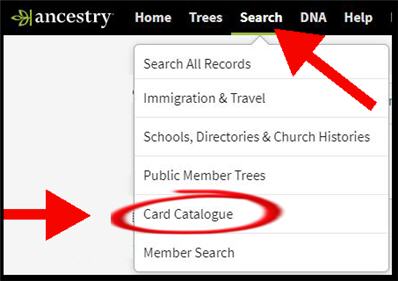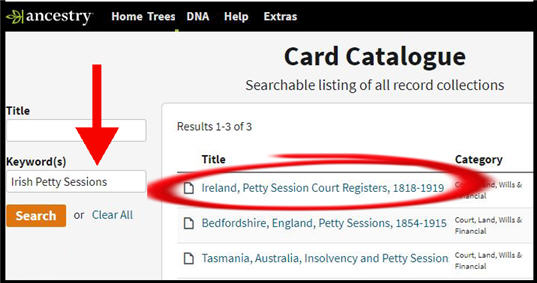Ancestry.com launched a collection of Irish Petty Sessions records in 2020. There are over 23 million records in this collection spanning a period of 1818 to 1919.
This article looks at how to get the best use of these records when you’re researching family history.
We also look at where you can find this collection elsewhere. You may not need an Ancestry.com subscription if the court records are all you want.
How To Find The Irish Petty Sessions Records On Ancestry.com
When you expand the Search drop-down menu on any Ancestry page, you can pull up a Catalog search page to look through the entire record collection on the website.

Don’t bother with the Title search box because this has to be an exact match. Instead, enter “Irish petty sessions” into the Keyword input box.

You’ll see “Ireland, Petty Sessions Court Registers” in a shortlist of options.
Now you can access the specific search page for the collection.
Some record sets are small enough to browse through the entire collection at your leisure. In contrast, the Irish Petty Sessions have over 23 million records in the collection.
So, you want to use additional filters to focus your research. Even just using a surname may have pages of results, so you’ll probably want a further filter on a location.
For the best choice of location, it’s important to understand how these courts were arranged throughout the country. We’ll explain the geography in the next section.
What Were The Petty Sessions In Ireland?
The Petty Sessions were the lowest level of courts in Ireland in the 19th and 20th centuries.
These courts presided over the least serious criminal and civil proceedings.
When were the Petty Sessions taking place?
Some form of these Sessions were around in the 18th century, but they were first legislated for in 1827. There was no jury in these courts. The judgments were handed down by the man appointed as Justice of the Peace (JP).
The role was unpaid and most would have had no formal legal training. The position was usually filled by a local landowner. This inevitably led to questionable justice in these times.
The Petty Sessions (Ireland) Act in 1851 was brought in by the Government in response to growing complaints. By the late 19th century, paid and trained magistrates were more common.
The geography of the Petty Sessions courts
The 1851 act divided each of the 32 counties into districts. For example, County Wicklow had 14 districts. Each court within a district sat once a fortnight.
When I’m using the search features on Ancestry.com, I like to filter by an entire county when looking for specific ancestors. I tend not to drill down to a smaller townland or parish.
Most of my miscreant relatives turn up in the single district nearest them, but I don’t want to miss wanderers who ended up in a neighboring district.
What kind of crimes were heard in these courts?
These are the criminal and civil proceedings in which my ancestors appear:
- Cattle wandering into a neighbors land
- Cutting and taking turf
- Drunkenness in public
To be fair, my ancestors weren’t always the defendants! Sometimes they appear as witnesses, which can be a good indication of neighboring families.
Crimes involving drunkenness account for one-third of the cases in front of these courts.
It’s worth knowing that the Temperance movement was in full sway, which put pressure on local constabulary to crack down on drinking in public.
What kind of punishments were meted out?
The common punishment for milder offenses was to be bound to the peace.
Fines of a shilling or more were also often seen. But many of the poor folk in front of the courts would have no ability to pay a fine. This meant that prison was the option.
The maximum punishment that these courts could give was one year in prison. Higher punishments were reserved for the higher courts. A prison sentence could also include hard labor.
Related collections on Ancestry
If you see that your ancestor or relative is handed a prison sentence, then you should check out our guide to the Irish Prison Registers on Ancestry.com.
Who Recorded The Irish Petty Sessions?
The clerks of the courts documented each court session. Each clerk documented the cases before the court into a daily ledger known as the Order Book. The images you’ll see on Ancestry.com are pages from these ledgers.
The role of clerk was sometimes passed down through generations. Let’s take a look at two notable figures who followed their fathers into the role.
Georgina Frost
Georgina Frost made history by being the first female elected official in England and Ireland.
Georgie Frost’s father and grandfather had been clerks of the court. When the young woman sought the position in a district in County Clare, the local authorities duly elected her.
However, she was barred from taking the role by the higher authorities. Frost took her case to court and won the right to do her duties.
Bram Stoker
Bram Stoker is famous for being the author of Dracula. But before he authored the famous novel, he followed his father into a role of court clerk.
Stoker rose in the ranks to become an inspector of petty sessions and wrote a textbook on the subject.
What Is In The Court Records?
The court records are very detailed. The searchable transcripts have a subset of the full information on the original image.
Here’s what is in the transcript:
- first and last name
- trial date
- court name and place
- place of residence of the person
- role of the person (complainant, defendant, witness)
Be sure to review the associated image for more details!
What’s in the image?
When you open the image of the record, you’ll see an image of the page from the ledger book that records the specific case. There are a few other cases on the page.
The main problem for us now is that the clerk had to cram a lot of information into a small space. Be sure to make full use of the Zoom function!
These are the recorded details for each case in the image:
- Date of the offense
- Nature of the offense
- Details of the defendant(s)
- Details of the complainant(s)
- The witnesses
- The sentence handed down
- Names of the judge and constabulary
Tips For Using The Irish Petty Session Records
The civil complaints can be very useful for gleaning new information about family structures.
Take a careful look at the list of witnesses. I have found that these are often family members. There’s nothing better than spotting a new person with the same surname that you’ve been researching.
If there’s a woman with a surname you don’t recognize, it’s worth investigating if she is a family member who had married by the time of the court case.
The civil cases are often complaints and squabbles between neighbors, who may also belong to the same extended family.
If your ancestor is fined for straying livestock causing damages, this can help you figure out the topography of adjoining farms. If you want to go further, the census records of 1901 and 1910 can help with this.
It’s also worth noting that petty sessions were a constant source of material for local newspapers. Everyone loves to read about their neighbors’ troubles!
Check out our review of the newspaper collection on Ancestry.com.
Do Other Sites Have This Collection?
The original court order books are held at the National Archives Of Ireland. They are available to view on microfilm when you visit the archives in Dublin. The National Archives haven’t put them online.
The microfilming was done by FamilySearch.org. FamilySearch.org entered into a partnership with Find My Past to help with transcripts and indexation.
Find My Past was the first to publish searchable transcripts as part of their subscription. Their collection became available back in 2008.
Ancestry.com purchased the record collection from Find My Past and included it in their own archive in 2020. This is part of their citation: “Records extracted by Findmypast and images digitized by FamilySearch.”
So, let’s summarize availability outside of Ancestry.com.
FamilySearch
FamilySearch.org offers free membership to search their online record collections. Their record transcripts include these limited details: name, date, court district, and role.
However, the image is not available for general use on the FamilySearch website. Instead, they provide a link to open the image within the Find My Past collection. You would need to have a subscription to Find My Past to view the images there.
The alternative is to visit a Family History Center run by FamilySearch.org. If you use their terminals, you will get free access to the images on Find My Past.
Find My Past
Find My Past offers the full collection with transcripts and images as part of their subscription. I’ve written a separate guide on Irish Petty Sessions on Find My Past.